- Home
- John Barth
The Friday Book
The Friday Book Read online
For Shelly
Copyright © 1984 by John Barth
All rights reserved
Printed in the United States of America on acid-free paper
Originally published in a hardcover edition by G. P. Putnam’s Sons, New York, 1984
Maryland Paperback Bookshelf edition, 1997
06 05 04 03 02 01 00 99 98 97 5 4 3 2 1
The Johns Hopkins University Press
2715 North Charles Street
Baltimore, Maryland 21218-4319
The Johns Hopkins Press Ltd., London
Several pieces in this book have been published previously, and the author gratefully acknowledges the following sources: Antaeus for “Tales Within Tales Within Tales”; The Atlantic for “The Literature of Exhaustion” and for “The Literature of Replenishment: Postmodernist Fiction”; The Boston Globe for “Speaking of LETTERS”; Esquire for “Revenge”; The Johns Hopkins Press for the forward to Western Wind, Eastern Shore: A Sailing Cruise Around the Eastern Shore of Maryland, Delaware, and Virginia by Robert de Cast; The David McKay Company, Inc., for “Writer’s Choice” from Writer’s Choice, edited by Rust Hills; New American Library for the afterword to Roderick Random by Tobias Smollett; The New York Times, Inc., for “Some Reasons Why I Tell the Stories I Tell the Way I Tell Them Rather Than Some Other Sort of Stories Some Other Way,” which appeared as “The Making of a Writer,” and for “Getting Oriented”; The Pennsylvania State University Press for “The Ocean of Story” from Directions in Literary Criticism, edited by Weintraub and Young; The Washington Post Sunday Magazine for “Historical Fiction, Fictitious History, and Chesapeake Bay Blue Crabs, or, About Aboutness.”
Designed by Helen Barrow
The text of this book is set in Times Roman and Helvetica Light.
Library of Congress Cataloging-in-Publication data will be found at the end of this book.
ISBN 0-8018-5557-8 (pbk.)
A catalog record for this book is available from the British Library.
The Title of This Book
Book-titles should be straightforward. Book-Titles Should Be Straightforward is not quite straightforward (see below)—nor is it quite the title of this book. The Canterbury Tales, A Cruising Guide to the Chesapeake, The Trial, The Idiot, Moby-Dick, The Anatomy of Melancholy, The Friday Book —those are straightforward.
Comic works need not bear comic titles. The Frogs. The Birds. Don Quixote. Tom Jones. A catchy title may serve a catchy book (Catch-22 is not a title with a catch to it; it is straightforward): Two truly catchy books by the logician Raymond Smullyan—What Is the Name of This Book? and This Book Needs No Title —have appropriately catchy titles. But better a book more engaging than its title (The Adventures of Huckleberry Finn) than a title more engaging than its book (Steal This Book, by Abbie Hoffman).
Later in the course—the course of this arrangement of miscellaneous nonfiction by a habitual novelist and occasional short-storyteller who has also for three decades professed the reading and writing of fiction in American universities and along the way has entertained a couple of ideas at a time about literature—we may touch upon other principles and categories of literary titling and upon titling errors to be avoided.
Indeed, let us touch upon them now and have done with it: I mean such misdemeanors as Titles Quoted From Even Better Works Than One’s Own (The Sun Also Rises, The Winter of Our Discontent, Tender Is the Night), Hokey-Romantic Titles (How Green Was My Valley, Winter Blood, Not as a Stranger, The Executioner’s Song), especially Tacky Tandems (War and Peace is straightforward; Pride and Prejudice and Sense and Sensibility are nearly so, but for the alliteration. The Beautiful and Damned, The Naked and the Dead, The Agony and the Ecstasy —these are the Tacky and the Poshlost: see below), Poetical Inversions (By Love Possessed, Too Late the Phalarope, After Many a Summer Dies the Swan), and other varieties of what the late Vladimir Nabokov called by the Russian word poshlost: a word adequately denned for our purposes by the samples given. Such titles may happen to entitle works otherwise innocent of hoke, affectation, pretentiousness, tack, poshlost; such works are not better for their titles.
Then there is the Self-Referential Title, which refers not to the subject or to the contents of the work but to the work itself. The Bible. Samuel Beckett’s film Film; his play Play. Fulton Oursler’s The Greatest Story Ever Told is not mainly self-referential and therefore is not essentially boastful: It refers less to the book it entitles than to the book that that book is about: i.e., The Book. Its element of ironic or at least amused self-referentiality is, however, part of the title’s point, as it is in the title of Philip Roth’s novel The Great American Novel. Quite all right.
The Canterbury Tales refers not primarily to Chaucer’s book thus named but to the tales told in it, the Canterbury tales, and thus is not self-referential; the same is true of Boccaccio’s Decameron, Marguerite of Navarre’s Heptameron, Giambattista Basile’s Pentameron, Somadeva’s The Ocean of Story, the Panchatantra, the Vetalapanchavimsata (25 Tales Told by a Vampire), and most other tale-cycle titles. The title of the ancient Egyptian Book of the Dead, like that of the modern Guinness Book of World Records, is semi-self-referential: It names both the container and the thing contained, as if one were to label a jar of apple jelly not Apple Jelly but Jar of Apple Jelly. The Kitab Alf Laylah Wah Laylah, or Book of the Thousand Nights and a Night, would seem to be in this category as well, but in curious fact it refers immediately neither to the book thus titled nor to the period of Scheherazade’s liaison with King Shahryar, but rather to a book described by the book thus titled, itself entitled The Marvels and Wonders of the Thousand Nights and a Night, which book in turn, the text itself explains, is a popular edition of yet another book (in thirty volumes) called The Stories of the Thousand Nights and a Night. That is the original book of the scribes’ transcription of the tales told by Scheherazade to the king, plus the tale of Scheherazade telling those tales to the king. The book we hold in our hands is a book about a book about that book; it might properly be entitled The Book of the Book of the Book of the Thousand Nights and a Night.
Rather, it is a copy of a translation of that book about that book about that book, just as that innermost book is a written copy of Scheherazade’s spoken tales, themselves recited from her memory of the “thousand books of histories” in her personal library and the “works of the poets,” which she knew “by heart.” Such several removes between us and the original tales—removes acknowledged in many cases explicitly, if in passing, by the text itself—suggest an awareness among the ancients in many cultures of what in Hebrew tradition is implied by the Cabalistic notion of The Original of the Book: an original we can only infer from however “authoritative” a copy, even the author’s manuscript. I have for example revised this paragraph a number of times on a number of Friday mornings here in my workroom overlooking Langford Creek on the Eastern Shore of tidewater Maryland and have not got it quite right yet, have not got it right quite yet, have not yet got it right, quite, but like the tide I shall move on now and later return. More about tales within tales and tales about tales in the pages to follow, and considerably more about Scheherazade. Also tides.
The difference between Self-Referential Titles like the Bible or Film, Self-Reflexive Titles like The Title of This Book, and Self-Demonstrating Titles like Book-Titles Should Be Straightforward is that the first name the thing they name (at least a copy of that thing), the second name the name of the thing, as the name name names itself, and the third exemplify not only what they are but what they say. Inasmuch as the names of things are also members of the class of things, things in the world, a perfectly self-reflexive sentence such as Adjective adjective subject adverbially verbs adjective adjective object is as meaningful, though its content is no
t in itself so moving, as the sentence Old King Priam tearfully kisses Achilles’s bloody hands.
The late John Gardner was pleased to argue that sentences like the latter make up what he called Primary Literature—literature about “life”—whereas the former add up to Secondary Literature: literature about literature, or in this case language about language. One understands what he meant (Homer’s powerful scene in Book XXIV of the Iliad, of Priam kissing Achilles’s hands, still bloody from Hector’s slaughter, in vain supplication to return his dead son’s body, was one of Gardner’s favorite examples of Primary Literature). But since one may write stirring sentences about matters in themselves unstirring or even nonsensical (“And hast thou slain the Jabberwock? Come to my arms, my beamish boy!”), and unstirring sentences about stirring matters (“Homer’s powerful scene in Book XXIV of the Iliad…” above), the issue is far from simple. Such distinctions as Primary and Secondary Literature, particularly when they become value judgments, do more to becloud than to clarify the manifold processes of language and literature, which, like many other processes both “natural” and artificial, from walking upright to welding automobile frames by computerized robot, depend upon more or less subtle and intricate “feedback loops” for their success. Surely we do better to acknowledge that literature, like language, is seldom simply but always also about itself. Titles too, about which this is enough.
Four mornings a week from September through May I have for some years been privileged to make up and set down my stories in a pleasant white house in the city of Baltimore, where in the afternoons I teach at the Johns Hopkins University. On normal Thursday evenings my wife and I drive across the Chesapeake Bay Bridge to a pleasant red house on Langford Creek, off the Chester River, off that same Bay, where on Friday mornings (unless the story in progress asserts the priority reserved to it) I refresh my head with some other sort of sentence-making, preferably nonfiction, while Shelly does schoolwork. Two English teachers. Most of the pieces here edited, revised, and assembled were in fact composed before I was blessed with this tranquil work-rhythm, from which only the later ones proceed. But I find that rhythm so agreeable that in the summer months too, when teaching and weekend-commuting are suspended and we live and work only in our creekside house, hoping the world will not soon end, I still reserve the last weekday morning for whatever “Friday-piece” is in hand, and I hope to do so until the period of my life’s sentence.
Though I am far from regretting that sentence—which in the main has been thus far a serene, productive, and rewarding one—if I could revise it to my preferences, the pieces here collected would all have been written on Friday mornings on Langford Creek; then The Friday Book, itself conceived and executed over a year’s Fridays, would be my Friday book indeed.
Prefatory notes and other introductory material should be avoided wherever possible. See “Author’s Introduction.”
The Subtitle of This Book
Subtitles—like printed dedications, notes on titles, author’s introductions, forewords, sonnets and epistles dedicatory, and the rest—should be avoided. Get on with it. Get on with it.
But if you must use a subtitle, at least eschew the archaizing or, followed by cutesy fake earlier-centuryisms. Or, the Whale is quite all right for Moby-Dick, or was in the nineteenth century. Erica Jong’s Fanny: Being the True History of the Adventures of Fanny Hackabout Jones, can be justified as the title and subtitle of a twentieth-century novel humorously imitative of eighteenth-century fiction—a category of humorous twentieth-century fiction one would have thought exhaustible by a single instance, but its appeal seems to be as perennial to Americans as other fake colonialisms.
Subtitles are usually made necessary by titles with more “grab” than straightforwardness. The American Heritage Dictionary of the English Language requires no subtitle. Book-Titles Should Be Straightforward is intelligible but requires at least the subtitle Essays and Other Nonfiction to make it meaningful. Sub-subtitles like Subtitles Should Be Avoided should be avoided if only because though fairly straightforward they necessitate a sub-sub-subtitle, in this case Essays and Other Nonfiction, which, had it been used as the book’s title in the first place, would have been perfectly straightforward and required no subtitles.
This is not to say that no straightforward title requires subtitling. It is useful to know whether the title Baltimore is subtitled A Picture History or Telephone Directory. Straightforwardness, moreover, while a virtue, is not the only virtue; therefore one sees titles which sin against no other principle of titling than straightforwardness and are doubtless more arresting or engaging than Fifty Stories or Tales of the Chesapeake, but may require subtitling. Should you perpetrate such a title, follow it with a subtitle which not only is straightforward but manages also to avoid the as fetish worshipped in particular by literary critics: Literature as Equipment for Living. Language as Gesture. Subtitles as Literary Genre. Say it straight. Get on with it.
Author’s Introduction
The chief purpose of introductions (I like to say when introducing guest authors to their public audiences at Johns Hopkins, in whose Writing Seminars I preside over advanced, unadvanced, and backward apprentice writers of fiction, coaching the first, instructing and encouraging the second, and gently hoping that the third will find another métier) is to test the public-address system. Introductions ought therefore to extend beyond a single breath, but not much beyond. They also permit latecomers to be seated and the guest author to size up his/her house and perhaps make appropriate program adjustments.
There are a number of Rules for Public Introducing, of which the first is Do not upstage the introducee by introducing him/her with cleverer remarks than he/she is likely to make him/herself and the second is Never introduce either a speaker or a text with an attempted parody of him/her/it, for if your attempt is successful you have broken Rule One, and if it is not you have been at least faintly foolish.
Introduction to a course of study is better done by a straightforward syllabus, to a body of assorted nonfiction by a straightforward table of contents, than by one more nattering text-before-the-text. Eschew introductions wherever possible. What cannot be eschewed, swallow hard and abbreviate. Above all, avoid any version, especially any clever version, of the introduction “This author [course, text, whatever] really needs no introduction.”
If you yourself are the author/teacher, and your presentation is after all largely self-explanatory—an arrangement of your essays and occasional lectures, some previously published, most not, most on matters literary, some not, accumulated over thirty years or so of writing, teaching, and teaching writing, interstitched with little lessons on the manufacture of fiction, presentations to sundry symposia, remarks upon your work and your life as an American writer in the second half of the twentieth century, and other “continuity” material (not to be confused with “filler”: Continuity, like discontinuity, has its place in writing which takes its readers seriously; “filler” does not), and here as they say collected for the first time—you should dispense with introductions and get on with the job.
Ms. Katha Pollitt, reviewing in the New York Times a 1983 volume of essays by Ms. Cynthia Ozick, writes, “This is not your typical collection of essays by an eminent middle-aged writer of fiction. You know what sort of book I mean—a graceful miscellany of book reviews, introductions, and speeches, all wrapped up and offered to the public less as a book, really, than as a kind of laurel, a tribute to the author’s literary importance.” Okay: This book is that sort of book, except that it contains no book reviews—my vows to the muse, made long ago and reasonably well kept, prohibit among other things the giving or soliciting of advertising testimonials and the reviewing of books—and I offer it to the public after all less as a kind of laurel than as an honest-to-goodness book.
J.B.
Baltimore/Longford Creek, Md., 1983/84*
* James Joyce made these subscripts fashionable with his Trieste-Zurich-Paris, 1914-1921 at the foot of Uly
sses: a kind of navigational fix on literary high modernism. It is a practice of no artistic value whatever and therefore better eschewed, though in the case of American writers the dates of composition may be of interest to the Internal Revenue Service.
Table of Contents*
The Title of This Book
The Subtitle of This Book
Author’s Introduction
Table of Contents
Epigraphs
Some Reasons Why I Tell the Stories I Tell the Way I Tell Them Rather Than Some Other Sort of Stories Some Other Way
How to Make a Universe
More on the Same Subject
An Afterword to Roderick Random
Mystery and Tragedy
Muse, Spare Me
The Tragic View of Recognition
The Literature of Exhaustion
More Troll Than Cabbage
The Role of the Prosaic in Fiction
The Ocean of Story
A Poet to the Rescue
Aspiration, Inspiration, Respiration, Expiration
The Tragic View of Literary Prizes
Praying for Everybody
Doing the Numbers
Intelligent Despisal
Writer’s Choice
Western Wind, Eastern Shore
The Spirit of Place
Getting Oriented
My Two Problems: 1
My Two Problems: 2
My Two Problems: 3
My Two Uncles
My Two Muses
The Future of Literature and the Literature of the Future
Algebra and Fire
Speaking of LETTERS
Historical Fiction, Fictitious History, and Chesapeake Bay Blue Crabs, or, About Aboutness
The Literature of Replenishment
The Self in Fiction, or, “That ain’t no matter. That Is nothing.”
Revenge
Tales Within Tales Within Tales

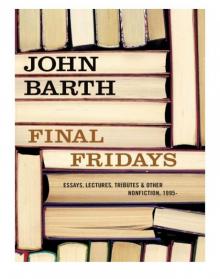 Final Fridays
Final Fridays Where Three Roads Meet: Novellas
Where Three Roads Meet: Novellas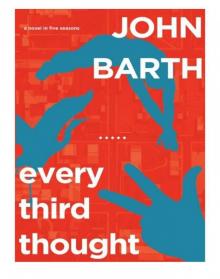 Every Third Thought: A Novel in Five Seasons
Every Third Thought: A Novel in Five Seasons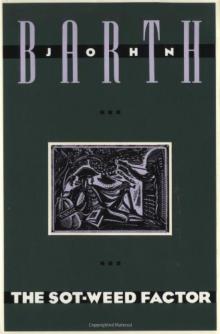 The Sot-Weed Factor
The Sot-Weed Factor The Friday Book
The Friday Book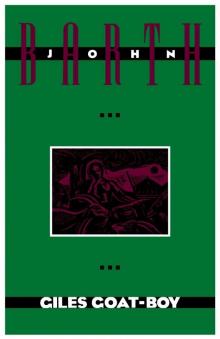 Giles Goat Boy
Giles Goat Boy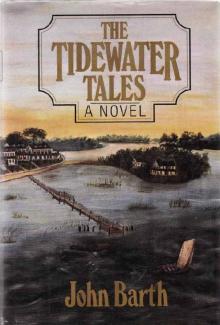 The Tidewater Tales
The Tidewater Tales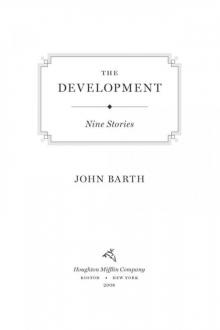 The Development
The Development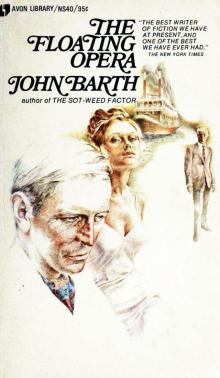 The Floating Opera
The Floating Opera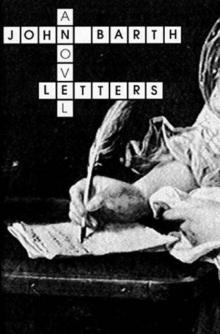 Letters
Letters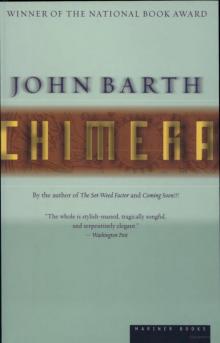 Chimera
Chimera Where Three Roads Meet
Where Three Roads Meet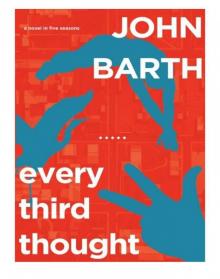 Every Third Thought
Every Third Thought